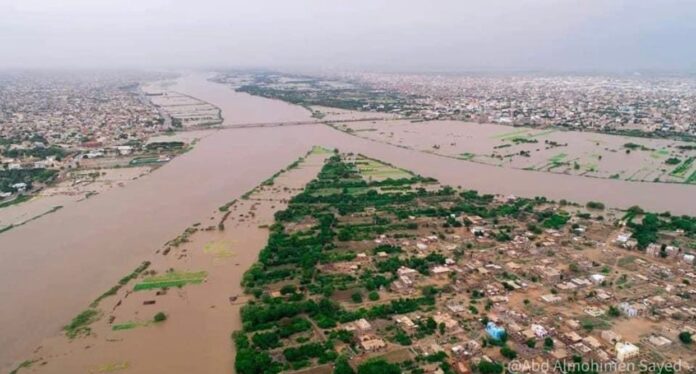Floods in the Nile Basin:
The Need for External Mediation for Effective Partial Coordination Among the Three States
Policy assessment by: Zaelnoon Suliman, Progress Centre for Policies
The Reality Behind the Source of the Floods Amid the Egyptian and Ethiopian Claims:
The Blue Nile is the main factor and direct cause of flooding, as the strength and speed of its flow and the rise of its water level during the Ethiopian highland rainy season increase the volume of water flowing into the river’s main channel.
The Blue Nile is about 1,450 kilometers long and is characterized by its abundant water and steep gradient caused by heavy rainfall over the Ethiopian highlands. This makes it the primary source of the waters that cause flooding in Sudan and Egypt.
The White Nile, on the other hand, is characterized by a steady flow and a stable water level throughout the year. It originates from Lake Victoria and extends for about 3,700 kilometers to Khartoum. The river loses more than half of its water in the swamps of South Sudan due to intense evaporation and high temperatures, resulting in a slow and weak current compared to the Blue Nile.
When the two rivers meet in Khartoum, sudden increases in the Blue Nile’s waters create significant hydraulic pressure on the White Nile, impeding its flow and pushing its waters toward the riverbanks. This contributes to flooding in areas along the White Nile and other nearby regions.
Summary and Conclusions:
The three parties to the Grand Ethiopian Renaissance Dam (GERD) crisis have used Sudan’s flood disaster to reinforce their political and technical positions. Egypt accuses Ethiopia of managing the dam unilaterally and irresponsibly, without coordination. Addis Ababa, in contrast, denies any responsibility for the floods, claiming the dam actually helped regulate Nile flows and reduce water fluctuations. Sudan, caught in internal turmoil due to the conflict between the army and the Rapid Support Forces, has taken a relatively neutral stance that prioritizes its security interests.
Egypt’s accusation of Ethiopia’s lack of transparency in dam operations, Sudan’s acknowledgment of fluctuating water levels due to dam discharges, and Ethiopia’s absolute denial—all in the absence of a binding operational agreement—reflect a severe trust deficit in hydrological data sharing among the Nile states.
Cairo’s statements emphasize that unilateral water resource management poses a direct threat to the water security of downstream countries and effectively serve as a warning of potential security repercussions. The lack of sustained tripartite coordination among Egypt, Sudan, and Ethiopia significantly aggravates water crises and amplifies their regional consequences.
The flood disaster in Sudan highlights the urgent need for the intervention of a neutral third party to establish a partial technical coordination mechanism among the three countries. This mechanism should temporarily manage shared water issues until a comprehensive settlement on the GERD dispute is reached. The urgency of this step stems primarily from humanitarian concerns and the need to avoid escalating tensions or potential conflict between Ethiopia and downstream states.
Establishing a joint technical platform based on satellite data and field monitoring would help forecast floods and flash floods, contributing to the protection of people and property in Sudan and Egypt.
The collapse of Sudanese state institutions due to the ongoing war has led to a decline in maintenance and monitoring of dams and reservoirs, due to shortages of technical staff, communication breakdowns, and lack of resources. This institutional weakness has undermined water management and flood monitoring, increasing water safety risks and underscoring the urgent need for external technical support to rehabilitate Sudan’s irrigation and dam systems.


